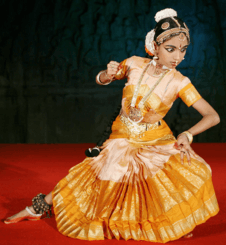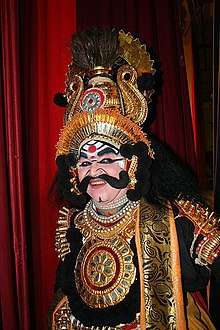Indian aesthetics
Indian art evolved with an emphasis on inducing special spiritual or philosophical states in the audience, or with representing them symbolically.
Rasas in the performing arts

The theory of rasas still forms the aesthetic underpinning of all Indian classical dance and theatre, such as Bharatanatyam, kathak, Kuchipudi, Odissi, Manipuri, Kudiyattam, Kathakali and others. Expressing Rasa in classical Indian dance form is referred to as Rasa-abhinaya. The Nātyasāstra carefully delineates the bhavas used to create each rasa.
The expressions used in Kudiyattam or Kathakali are extremely exaggerated theatrical expressions. The opposite of this interpretation is Balasaraswathi's school of subtle and understated abhinaya of the devadasis. There were serious public debates when Balasaraswathi condemned Rukmini Devi's puritanistic interpretations and applications of Sringara rasa. The abhinaya of the Melattur style of abhinaya remains extremely rich in variations of the emotions, while the Pandanallur style expressions are more limited in scope.
History
Natyashastra

Rasa theory blossoms beginning with the Sanskrit text Nātyashāstra (nātya meaning "drama" and shāstra meaning "science of"), a work attributed to Bharata Muni where the Gods declare that drama is the 'Fifth Veda' because it is suitable for the degenerate age as the best form of religious instruction. The Nātyashāstra presents the aesthetic concepts of rasas and their associated bhāvas in Chapters Six and Seven respectively, which appear to be independent of the work as a whole. Eight rasas and associated bhāvas are named and their enjoyment is likened to savoring a meal: rasa is the enjoyment of flavors that arise from the proper preparation of ingredients and the quality of ingredients.
Kashmiri aestheticians
The theory of the rasas develops significantly with the Kashmiri aesthetician Ãndandavardhana's classic on poetics, the Dhvanyāloka which introduces the ninth rasa, shānta-rasa as a specifically religious feeling of peace (śānta) which arises from its bhāva, weariness of the pleasures of the world. The primary purpose of this text is to refine the literary concept dhvani or poetic suggestion, by arguing for the existence of rasa-dhvani, primarily in forms of Sanskrit including a word, sentence or whole work "suggests" a real-world emotional state or bhāva, but thanks to aesthetic distance, the sensitive spectator relishes the rasa, the aesthetic flavor of tragedy, heroism or romance.
The 9th - 10th century master of the religious system known as "the nondual Shaivism of Kashmir" (or "Kashmir Shaivism") and aesthetician, Abhinavagupta brought rasa theory to its pinnacle in his separate commentaries on the Dhvanyāloka, the Dhvanyāloka-locana (translated by Ingalls, Masson and Patwardhan, 1992) and the Abhinavabharati, his commentary on the Nātyashāstra, portions of which are translated by Gnoli and Masson and Patwardhan. Abhinavagupta offers for the first time a technical definition of rasa which is the universal bliss of the Self or Atman colored by the emotional tone of a drama.
Inclusion of bhakti
In the literary compositions, the emotion of Bhakti as a feeling of adoration towards God was long considered only a minor feeling fit only for Stothras, but not capable of being developed into a separate rasa as the sole theme of a whole poem or drama. In the tenth century, it was still struggling, and Aacharya Abhinavagupta mentions Bhakti in his commentary on the Natya Shastra, as an important accessory sentiment of the Shanta Rasa, which he strove with great effort to establish. However, just as Shantha slowly attained a state of primacy that it was considered the Rasa of Rasas, Bhakti also soon began to loom large and despite the lukewarmness of the great run of Alankarikas, had the service of some distinguished advocates, including Tyagaraja. It is the Bhagavata that gave the great impetus to the study of Bhakti from an increasingly aesthetic point of view.
Attention to rasas
Poets like Kālidāsa were attentive to rasa, which blossomed into a fully developed aesthetic system. Even in contemporary India the term rasa denoting "flavor" or "essence" is used colloquially to describe the aesthetic experiences in films.
See also
- Abhinaya
- Bishōnen – A Japanese beauty concept with influence from Indian aesthetic concepts
- Nātyasāstra – An ancient Sanskrit text on performance arts and aesthetics
- Nātyakalpadrumam
- Rasa lila
- Sanskrit Literature
- Sanskrit Theatre
Further reading
- Sen, R. K., Aesthetic Enjoyment: Its Background in Philosophy and Medicine, Calcutta: University of Calcutta, 1966
- Sen, R. K., A Brief Introduction to a Comparative Study of Greek and Indian Aesthetics and Poetics, Calcutta: Sen Ray & Co., 1954
- Sen, R. K., Nature of Aesthetic Enjoyment in Greek and Indian Analyses, Indian Aesthetics and Art Activity, Simla: Indian Institute of Advanced Study, 1968
- Sukla, Ananta Charan, The Concept of Imitation in Greek and Indian Aesthetics, Calcutta: Rupa & Co., 1977
- Sukla, Ananta Charan, Understanding and Enjoyment in Aesthetic Experience, Journal of Comparative Literature and Aesthetics: 1978
- Sukla, Ananta Charan, Contemporary Indian Aesthetics, Milan (Italy): Rubberttino, 1995
- Sukla, Ananta Charan, Representation in Painting and Drama: Arguments from Indian Aesthetics, Journal of Comparative Literature and Aesthetics: 1992
- Sukla, Ananta Charan, Aesthetics Beyond/ Within Aesthetics: The Scope and Limits of Indian Aesthetics, Journal of Comparative Literature and Aesthetics: 1995
- Sukla, Ananta Charan, Rasa, Sringara and Sringara Rasa: Aesthetics as Mass Culture in Indian Antiquity, Lahti (Finland): 1995
- Sukla, Ananta Charan, Art, Nature and the Artifactuality of Art and Nature: A Plea for Environmental Aesthetics in Ancient India, Journal of Comparative Literature and Aesthetics: 1996
- Sukla, Ananta Charan, Art, Reality and the Reality of the Arts: Ontology, Representation and The Sister Arts Theory in Indian Aesthetics, Indian Response to Literary Theory, Delhi: 1996
- Sukla, Ananta Charan, Emotion, Aesthetic Experience and the Contextualist Turn, International Yearbook of Aesthetics: 1996
- Sukla, Ananta Charan, Dhvani as a Pivot in Sanskrit Literary Aesthetics, East and West in Aesthetics, Siena (Italy): 1997
- Sukla, Ananta Charan, Transculturality of Classical Indian Aesthetics, Frontiers of Transculturality in Contemporary Aesthetics, Turin (Italy): 2001
- Sukla, Ananta Charan, Contemporary Indian Aesthetics, Vishvanatha Kaviraja Institute (India): 1995
- Matthew Jones (January 2010). "Bollywood, Rasa and Indian Cinema: Misconceptions, Meanings and Millionaire". Visual Anthropology 23 (1): 33–43.
- Welch, Stuart Cary (1985). India: art and culture, 1300-1900. New York: The Metropolitan Museum of Art. ISBN 9780944142134.
External links
- Rasa (sentiments) and Bhāva (psychological states) - in the Natya-shastra